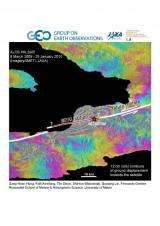New international satellite observations help assess future earthquake risk in Haiti

Virginia Key, Florida--Scientists at the University of Miami have analyzed images based on Synthetic Aperture Radar (SAR) observations taken before and just after Haiti's earthquake, on January 12. The images reveal surprising new details.
The images were obtained using data from Japan's ALOS satellite and made available to the scientific community through the efforts of the European Space Agency (ESA) and GEO, the Group of Earth Observation, an umbrella consortium of countries that promotes the exchange of satellite data to efficiently observe our planet.
According to the new data, the earthquake rupture did not reach the surface--unusual for an earthquake this size. More importantly, the images confirm that only the western half of the fault segment that last ruptured in 1751 actually ruptured in the current earthquake.
"We're still waiting for the other shoe to drop," said Tim Dixon, professor of geology and geophysics at the University of Miami Rosenstiel School of Marine & Atmospheric Science.
The images reveal other startling facts, "Given the plate tectonic setting scientists expected mainly sideways motion, yet there was a large amount of vertical motion during the earthquake," said Falk Amelung, professor of geology and geophysics at RSMAS. "This explains how such a relatively small rupture was able to generate such a large earthquake."
The data shows the earthquake occurred on or near the Enriquillo Fault, where most scientists suspected but until now did not have enough evidence to prove it. "This is a relief, because it shows that our current ideas about the tectonics of the area are correct," Amelung added.
Dixon is looking at every bit of evidence to try to understand the possibility of another major quake hitting Port au Prince in the near future. "There's a reasonable probability of another large quake, similar to the January 12 event, striking Port au Prince within the next 20 to 30 years," Dixon said. "I'd like to see them relocate critical infrastructure such as government buildings, schools and hospitals, farther north out of the danger zone."
In 1986, at the dawn of the GPS age, scientists from the National Aeronautics Space Administration (NASA) Jet Propulsion Lab, including Dixon began, a set of geodetic measurements on the island of Hispaniola. A decade later, those measurements would reveal that the Enriquillo fault in southern Haiti was a significant earthquake hazard. "In a very real sense, those early measurements set the stage for our current understanding of this dangerous fault zone. Scientists have been studying this fault and others on the island, ever since," Dixon said.
Shimon Wdowinski and Guoqing Lin, professors of geology and geophysics at RSMAS; Fernando Greene, graduate student at RSMAS and Sang-Hoon Hong, post-doctoral research scientist at RSMAS and at Florida International University also contributed to the analysis of the new images.
The work of the Rosenstiel School in active tectonics is supported by NASA, the National Science Foundation (NSF) and the National Earthquake Hazard Reduction Program (NEHRP). Other institutions involved in the analysis of the images included JAXA (the Japanese Space Exploration Agency) and NASA's Jet Propulsion Lab.
Provided by University of Miami Rosenstiel School of Marine & Atmospheric Science



















